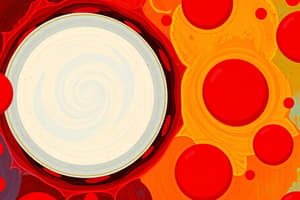Podcast
Questions and Answers
Which of the following is the primary function of the circulatory apparatus?
Which of the following is the primary function of the circulatory apparatus?
- Regulating body temperature and distributing hormones.
- Producing blood cells within the red bone marrow.
- Maintaining cellular stability by surrounding the cells with fluid.
- Transporting nutrients to cells and removing waste products. (correct)
Which component of blood is primarily responsible for oxygen and carbon dioxide transport?
Which component of blood is primarily responsible for oxygen and carbon dioxide transport?
- Plasma
- Red blood cells (Erythrocytes) (correct)
- Platelets (Thrombocytes)
- White blood cells (Leukocytes)
What is the approximate concentration of white blood cells (leukocytes) in blood?
What is the approximate concentration of white blood cells (leukocytes) in blood?
- 300,000 per mm²
- 8,000 per mm² (correct)
- 90% of blood volume
- 5 million per mm²
Which of the following best describes the role of platelets (thrombocytes)?
Which of the following best describes the role of platelets (thrombocytes)?
Which characteristic distinguishes red blood cells (erythrocytes) from other blood cells?
Which characteristic distinguishes red blood cells (erythrocytes) from other blood cells?
Plasma is composed of approximately what percentage of water?
Plasma is composed of approximately what percentage of water?
Which of the following is NOT a function of blood?
Which of the following is NOT a function of blood?
Which of the following is a characteristic of interstitial fluid?
Which of the following is a characteristic of interstitial fluid?
Which formed element of the blood is described as being not a 'real cell?'
Which formed element of the blood is described as being not a 'real cell?'
Which of the following do White Blood Cells not do?
Which of the following do White Blood Cells not do?
Where is blood formed?
Where is blood formed?
What two main components is blood made up of?
What two main components is blood made up of?
What three components make up the blood circulatory system?
What three components make up the blood circulatory system?
What approximate quantity of Red Blood cells are there?
What approximate quantity of Red Blood cells are there?
Which of the following is the most accurate number of White Blood Cell types?
Which of the following is the most accurate number of White Blood Cell types?
In addition to the blood circulatory system, what other circulatory system makes up the circulatory apparatus?
In addition to the blood circulatory system, what other circulatory system makes up the circulatory apparatus?
What approximate concentration of Platelets are there?
What approximate concentration of Platelets are there?
What shape does the plasma membrane of a red blood cell typically have?
What shape does the plasma membrane of a red blood cell typically have?
Which of these is the definition of the body's 'internal environment'?
Which of these is the definition of the body's 'internal environment'?
What is the water content of plasma?
What is the water content of plasma?
Flashcards
Interstitial Fluid
Interstitial Fluid
Liquid surrounding cells providing stability.
Circulatory Apparatus
Circulatory Apparatus
Carries nutrients, collects waste, and includes blood and lymphatic systems.
Blood Circulatory System
Blood Circulatory System
Blood, blood vessels and heart
Blood
Blood
Signup and view all the flashcards
Plasma
Plasma
Signup and view all the flashcards
Red Blood Cells (Erythrocytes)
Red Blood Cells (Erythrocytes)
Signup and view all the flashcards
White Blood Cells (Leukocytes)
White Blood Cells (Leukocytes)
Signup and view all the flashcards
Platelets (Thrombocytes)
Platelets (Thrombocytes)
Signup and view all the flashcards
Study Notes
- The internal bodily environment consists of interstitial fluid and the circulatory apparatus.
Interstitial Fluid
- It's a liquid that surrounds cells, providing stability.
Circulatory Apparatus
- Carries nutrients to cells and collects waste.
- Composed of the blood circulatory system and the lymphatic circulatory system.
Blood Circulatory System
- Consists of blood, blood vessels, and the heart.
Blood
- It's a red, viscous liquid flowing through blood vessels.
- Formed in the red bone marrow.
- Transports O2, CO2, nutrients, and waste products.
- Regulates body temperature.
- Protects the body from pathogens and distributes hormones.
- Consists of plasma and blood cells.
Plasma
- A yellowish liquid.
- Composed of 90% water.
- Contains several dissolved substances.
Red Blood Cells (Erythrocytes)
- The most abundant, with 5 million per mm².
- Have a biconcave shape.
- Transport O2 and CO2.
- They are born with a nucleus, but lose it to create space for O2 and CO2.
White Blood Cells (Leukocytes)
- There are 8000 per mm².
- They have a nucleus.
- They have a spherical shape.
- Part of the immune system.
- There are 5 types.
Platelets (Thrombocytes)
- There are 300000 per mm².
- Have an irregular shape.
- Not real cells, just pieces of cytoplasm.
- Responsible for blood coagulation.
Studying That Suits You
Use AI to generate personalized quizzes and flashcards to suit your learning preferences.




